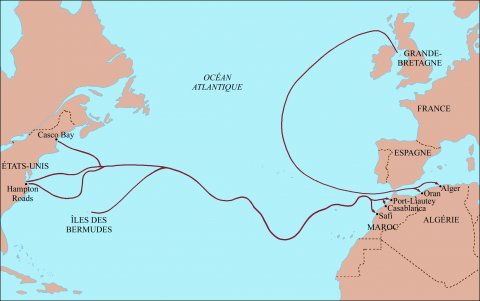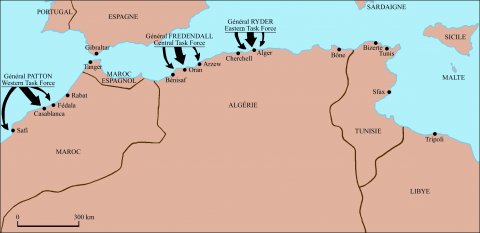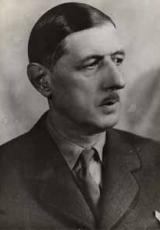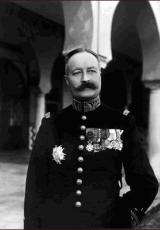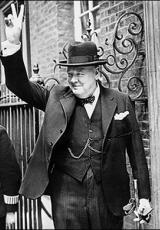Operation Torch: the Allied landings in North Africa
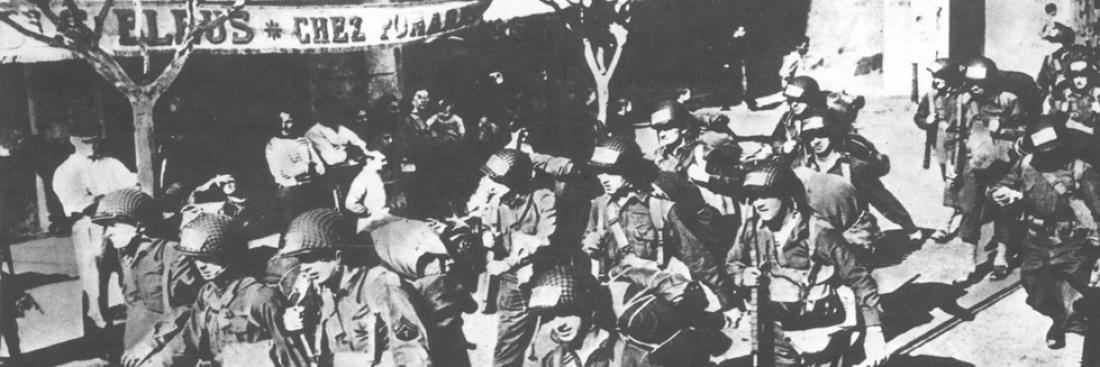
Source : Service historique de la défense
8 November 1942
In the spring of 1942, the Axis forces - Germany, Italy and Japan - were winning on all fronts: in Russia, in Africa and in the Pacific. Germany occupied a large part of Europe.
Victorious in the east, it was triumphing in Africa too, where German and Italian troops under General Rommel had recaptured Cyrenaica and were preparing to enter Egypt.
The successful landings in North Africa on 8 November 1942 were one of the elements that would sway the balance in the Allies' favour from that point on.
North Africa rather than Europe
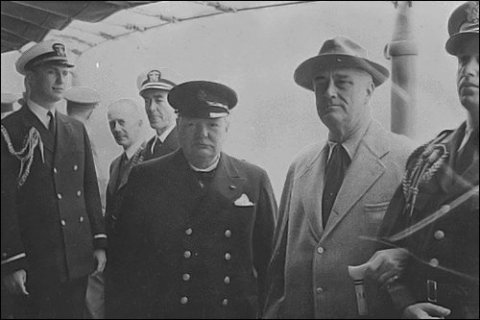
Prime Minister Winston Churchill and President Franklin D. Roosevelt on board the USS Augusta, off the coast of Newfoundland, August 1941.
United States Federal Government. Source: Public domain.
Since the United States' entry into the war, the British and Americans had been divided on what strategy to adopt to combat Germany. At the same time as maintaining the naval blockade, carrying out raids on the French coast and bombing Germany, Churchill wanted to pursue his policy of encircling the enemy by occupying the southern Mediterranean coast, an operation which could be carried out as early as spring 1942. To strike at Germany's heart while at the same time pleasing Stalin, who urged for a second front to be opened in the west, Roosevelt preferred a frontal attack, with landings directly in Europe. However, the state of the Allied forces meant that such an operation could not be envisaged before 1943. After several months of negotiations, in July 1942 the Americans gave their support to the British proposal. In late September, the plan was finalised, for landings in Morocco, Oran and Algiers.
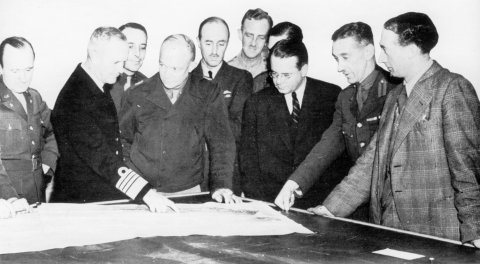
General Eisenhower, commander-in-chief of the Allied forces, and Admiral Cunningham, commander of the naval forces, study the landing plans.
Source: Service Historique
The search for legitimacy
Yet the operation threw up a crucial political question. Since they were part of the French Empire, Morocco, Algeria and Tunisia were subject to the authority of the Vichy Government, with which the Americans maintained diplomatic relations. The army re-formed after the armistice consisted of some 110 000 men. The Allies risked encountering strong opposition , which could potentially give rise to terrible fighting. A decision needed to be taken, therefore, as to whether contact should be made with the local Resistance or an agreement sought with the leaders of French North Africa. Wary of General de Gaulle, the leader of the Free French, who appeared to have little support in French North Africa, the Americans turned to General Giraud, who had escaped from Germany in April.
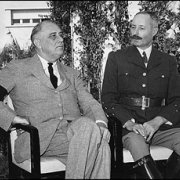
Franklin D. Roosevelt and General Henri Giraud in Casablanca, 19/01/1943.
United States Federal Government. Source: Public domain.
Giraud, who had spent much of his career serving in Africa, seemed to them more likely to rally the Army of Africa. Equally wary of senior civilian and military officials, they decided to rely on the support of the local Resistance because they could not run the risk of failure.
Robert Murphy, Roosevelt's advisor in French Africa since December 1940, was given the task of preparing the political terrain. In Algeria, he made contact with members of the Resistance, who obtained the support of a small number of French officers. On 23 October, not without risk, Eisenhower's deputy, General Clark, met in Cherchell with members of the Resistance to determine the nature of their assistance with the landings. On 2 November, an agreement in principle was signed with General Giraud.
The Allied invasion of Algeria and Morocco
Initially planned for 30 October, Operation Torch was postponed to 8 November. Under the command of General Eisenhower, the Anglo-American forces consisted of 200 warships, 110 troopships, 107 000 men and considerable air cover. The Western Task Force, arriving from the United States, would land in Morocco. The Center Task Force and Eastern Task Force, arriving from Britain, would attack Oran and Algiers.
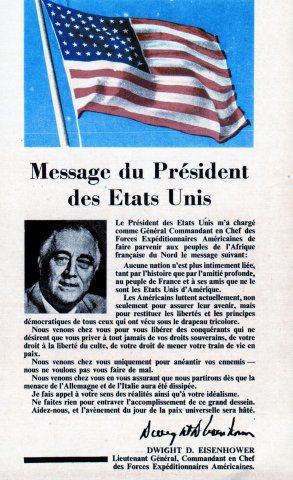
Front of leaflet distributed by American aircraft prior to the landings in North Africa. Source: Service Historique de la Défense
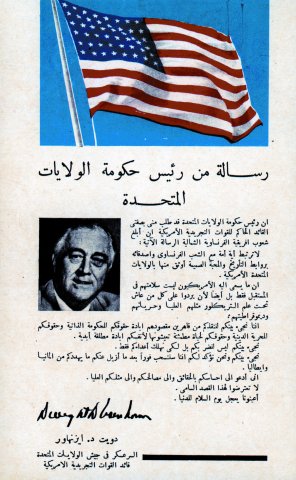
Reverse of leaflet distributed by American aircraft prior to the landings in North Africa.
Source: Service Historique de la Défense
At dawn on 8 November, the Allied fleet arrived at the Algerian and Moroccan coasts.
Route of the convoys. Source: Service Historique de la Défense
Click on the map to zoom in
The Allied landings in Algeria and Morocco. Source: Service Historique de la Défense
Click on the map to zoom in
Unstoppable progress in Algiers
At Algiers, operations went ahead without many problems, mainly thanks to the action of four hundred young Resistance fighters. After landing at 2.30 am, an hour after the scheduled time, the troops gained footholds near Sidi Ferruch, Castiglione and Cap Matifou. At Sidi Ferruch, the garrison rallied and put up no resistance. Elsewhere, the Allies' progress was hindered only by sporadic fighting.
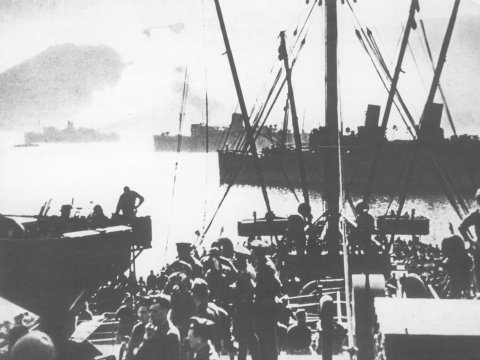
Admiral Cunningham's fleet in sight of the African coast. Source: Service Historique de la Défense
At the beaches of Cap Matifou, for instance, it took several hours to reduce a shore battery, with support from naval and air forces.
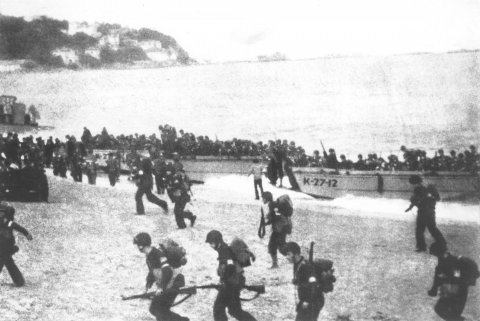
Troops land at Surcouf, near Algiers. Source: Service Historique de la Défense
In the port of Algiers, however, the Allies encountered more serious difficulties. Two British destroyers tried to force their way into the harbour to land an American detachment there. Caught in defensive fire, they were forced to withdraw, leaving behind 200 Americans who were quickly taken prisoner.
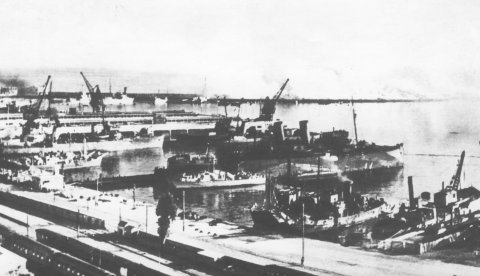
The Allied landings get under way at Algiers, under the protection of a smokescreen. Source: Service Historique de la Défense
Meanwhile, the Algerian Resistance, which had launched its operation the night before, seized a number of strategic administrative and military positions, cut power lines and telephone wires, and made prisoners of the main military leaders, including General Juin, commander-in-chief of the forces in French North Africa, and Admiral Darlan, commander-in-chief of the French forces, who happened to be in the country. It could not hold out for long, however, and the authorities quickly regained control of the city. But the Allies' progress was unstoppable and, by early afternoon, they reached the centre of Algiers. They would have to negotiate. Admiral Darlan authorised General Juin to make a deal with the Allies over Algiers. By late afternoon, a ceasefire was signed.
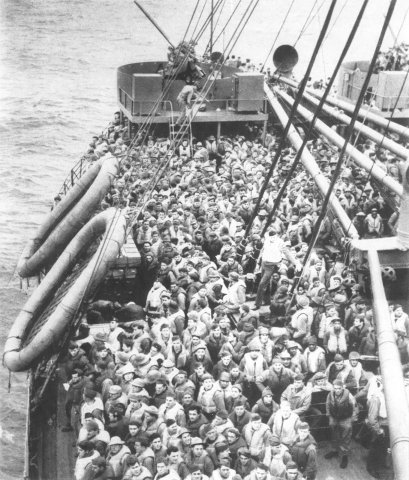
A troopship on its way to Oran. Source: Service Historique de la Défense
Fierce fighting at Oran and in Morocco
The same day, at Oran, the Army of Africa stood ready to repel any attack, on orders received from Vichy. The Allies landed at 2.30 am at Arzew, Les Andalouses and Mersa-bou-Zedjar, from where they converged on Oran. The Resistance, whose leader was arrested even before the operation began, were disorganised and unable to act. The defence was unremitting. The port of Oran could not be taken, nor could the base of La Senia.
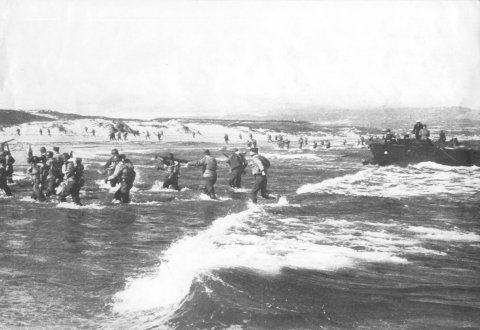
Landing at Arzew, east of Oran. Source: Service Historique de la Défense
In Morocco, where, as at Oran, the Resistance operation failed, orders were given to retaliate. The units, which began landing at 5 am at Fédala, Mehdia and Safi, came up against strong opposition. Violent fighting broke out at Mehdia and Port Lyautey.
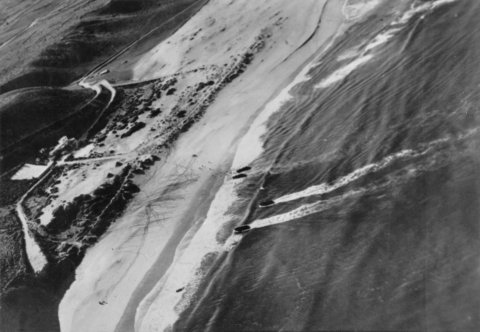
Allied reinforcements arrive at the beach of Fédala, near Casablanca. Source: Service Historique de la Défense
On the evening of 8 November, while fighting had ceased in Algiers, everywhere else the situation remained uncertain.
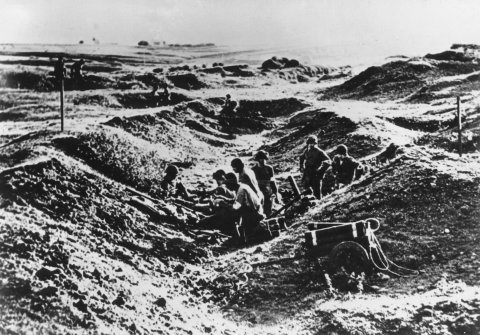
American soldiers take up their position between Fédala and Casablanca. Source: Service Historique de la Défense
In the absence of General Giraud - who was yet to arrive from Gibraltar, where he had met with General Eisenhower - the Americans turned to Admiral Darlan. On 9 November, Darlan met with General Clark to negotiate the terms of a general ceasefire. The next day, towards the end of the morning, he gave the order for fighting to cease. Oran had just fallen after a bitter struggle, but fighting in Casablanca went on until late into the evening.
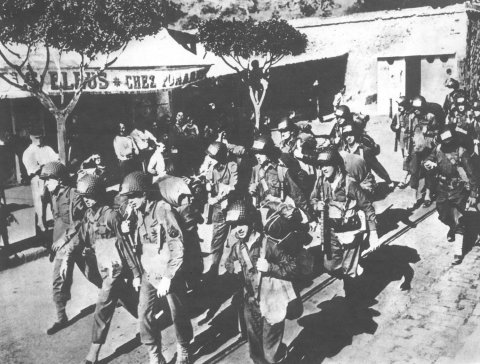
American soldiers march through the streets of Oran after landing. Source: Service Historique de la Défense
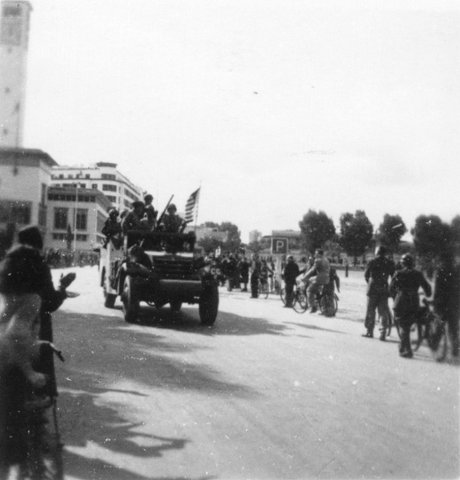
The Americans enter Casablanca - DMPA collection
The operation ended with 479 dead and 720 wounded, on the Allied side, and 1 346 dead and 1 997 wounded on the French side. The German reaction was immediate. On 11 November, France was completely occupied. On the 12th, German and Italian forces, the first of which had been sent as reinforcements on the 9th with the agreement of the Vichy Government, occupied Tunisia. On the 22nd, the Americans signed an agreement for political and military cooperation with Darlan. In North Africa, the French forces now constituted a threat to the Germans. They were preparing to rejoin the fight against the Axis powers, alongside the Allies, and the first step was to take back Tunisia.
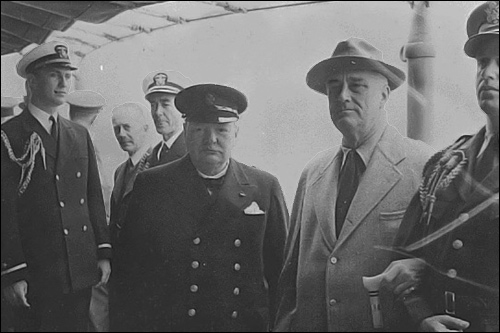
Le Premier ministre britannique Winston Churchill et le président Franklin Roosevelt à bord de l'USS Augusta, au large des côtes de Terre-Neuve, août 1941. United States Federal Government. Source : Photo libre de droit

Le général Eisenhower, commandant en chef des forces alliées, et l'amiral Cunningham, commandant des forces navales, étudient les plans du débarquement. Source : Service historique de la défense

Franklin D. Roosevelt et le général Henri Giraud à Casablanca, 19/01/1943. United States Federal Government. Source : Photo libre de droit
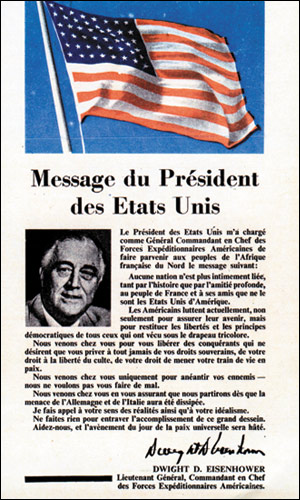
Tract, recto-verso, diffusé par avion par les Américains avant le débarquement en Afrique du Nord. Source : Service historique de la défense
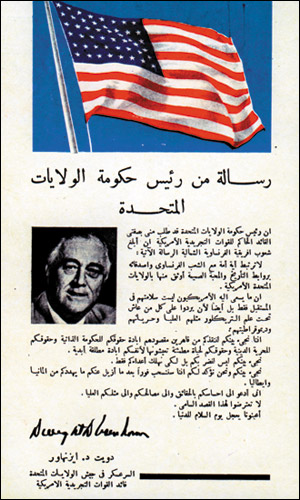
Tract, recto-verso, diffusé par avion par les Américains avant le débarquement en Afrique du Nord. Source : Service historique de la défense

Itinéraire des convois. Source : Service historique de la défense
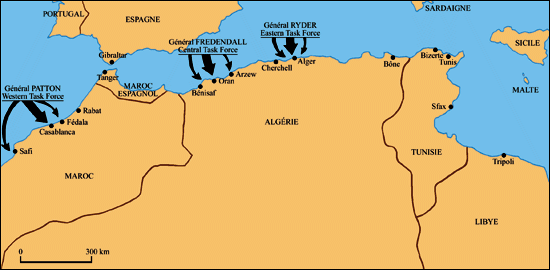
Les débarquements alliés en Algérie et au Maroc. Source : Service historique de la défense
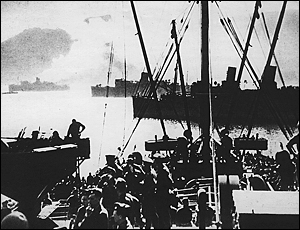
La flotte de l'amiral Cunningham en vue des côtes africaines. Source : Service historique de la défense
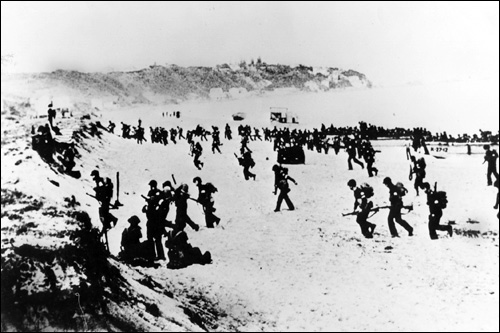
Débarquement des troupes à Surcouf, près d'Alger. Source : Service historique de la défense
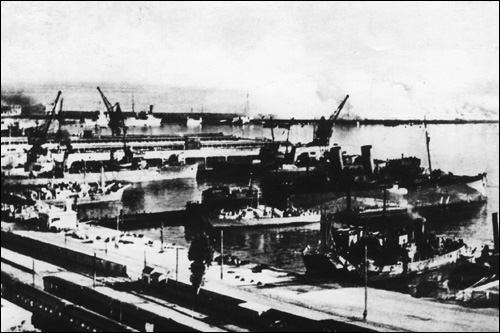
Sous la protection d'un écran de fumée, le débarquement allié commence à Alger. Source : Service historique de la défense

Un transport de troupes en route vers Oran. Source : Service historique de la défense

Débarquement à Arzew, à l'est d'Oran. Source : Service historique de la défense

Arrivée de renforts alliés sur la plage de Fédala, près de Casablanca. Source : Service historique de la défense

Soldats américains prenant position entre Fédala et Casablanca. Source : Service historique de la défense

Défilé des Américains dans les rues d'Oran après le débarquement. Source : Service historique de la défense


